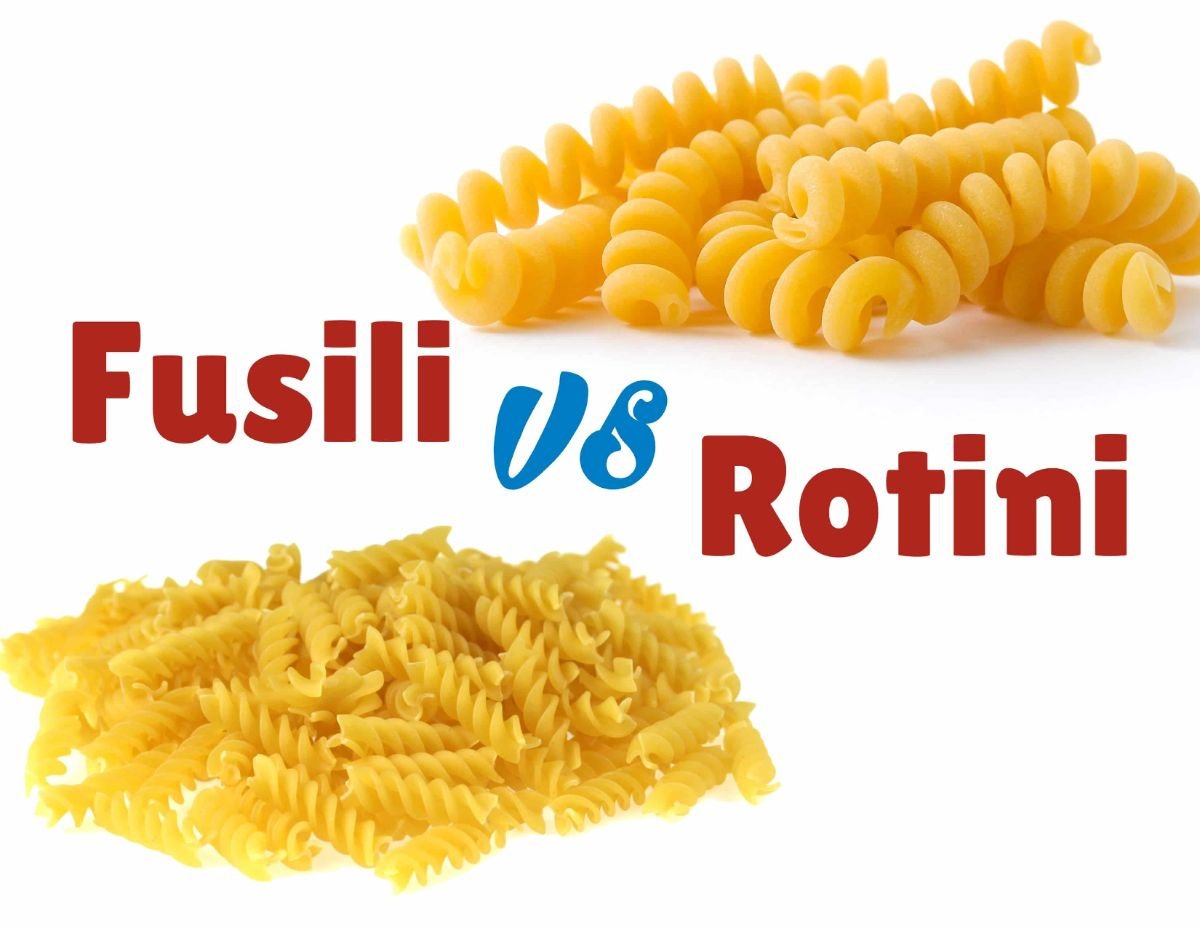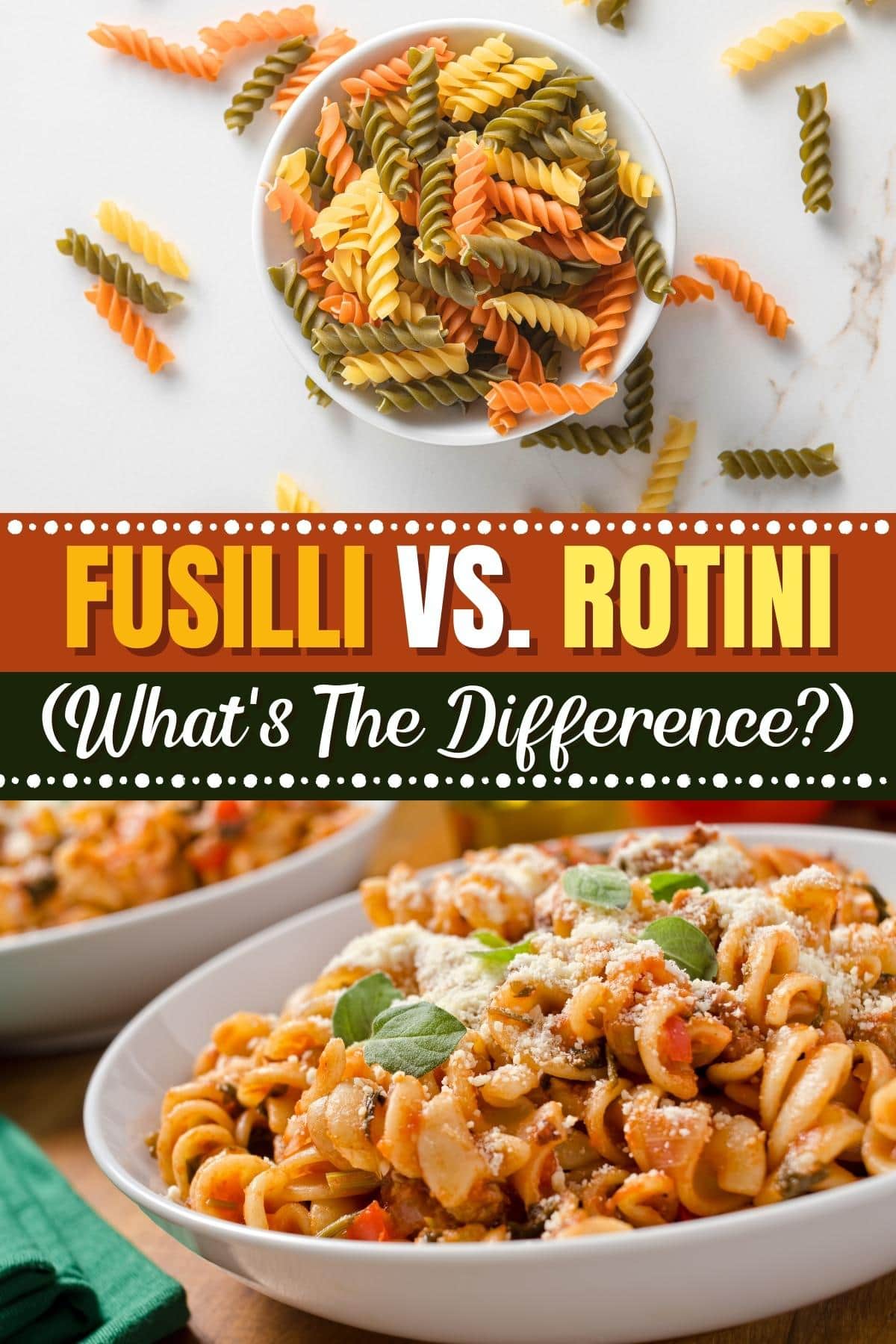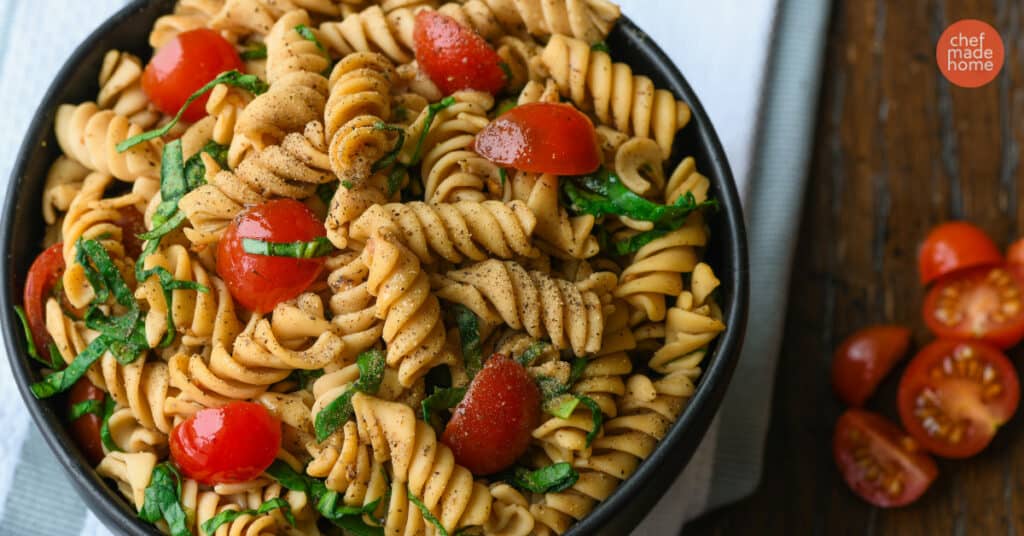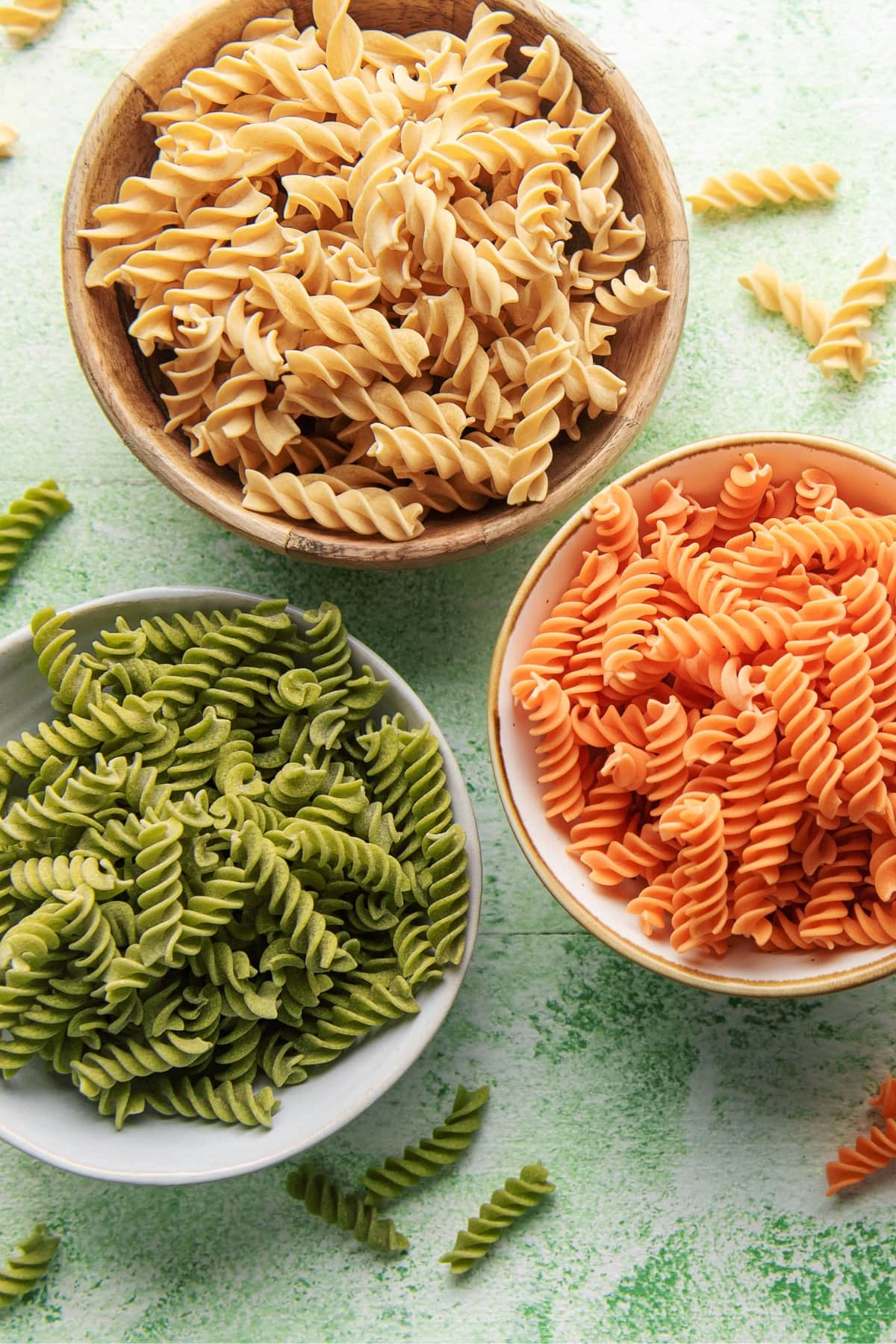Fusilli Pasta

Fusilli pasta, also known as “little spindles”, is a popular pasta shape that features long, twisted strands with a spiral-like shape. Its unique shape allows it to hold onto sauces and ingredients, making it perfect for dishes with chunky sauces or in pasta salads. Fusilli pasta originated in Southern Italy and is commonly made from durum wheat, giving it a firm texture when cooked. Its corkscrew-like shape adds a playful element to any dish and makes it a favorite choice for both kids and adults.
Fusilli Pasta: Origin And Characteristics
Fusilli pasta originated in Southern Italy and is known for its distinctive twisted shape. The word “fusilli” means “little spindles” in Italian, which accurately describes its appearance. Made from durum wheat, fusilli pasta has a firm texture when cooked, allowing it to hold up well in various dishes. Its corkscrew-like shape is not only visually appealing but also serves a functional purpose by holding onto sauces and ingredients. Its versatility makes it a popular choice for both traditional Italian recipes and creative, contemporary dishes.
Fusilli Pasta: Best Sauces And Recipes
Fusilli pasta’s corkscrew shape and firm texture make it perfect for holding onto robust sauces and ingredients. Some of the best sauces to pair with fusilli include tomato-based sauces like marinara or arrabbiata, creamy sauces such as Alfredo or carbonara, and pesto sauce.
In addition to sauces, fusilli pasta can be used in a variety of delicious recipes. It works well in pasta salads, baked pasta dishes like lasagna or casseroles, and even in stir-fries or one-pot meals. Its versatility allows for endless creative possibilities in the kitchen. So, whether you prefer classic Italian flavors or more adventurous combinations, fusilli pasta is sure to elevate your dishes.
Rotini Pasta

Rotini pasta, also known as “screw pasta,” is a type of pasta with a distinctive spiral shape. It is made from durum wheat and has a slightly firm texture when cooked. Rotini pasta is popular for its ability to hold onto sauces and ingredients, making it perfect for dishes like pasta salads and casseroles. Its unique shape also adds visual appeal to any dish. With its versatility and delicious taste, rotini pasta is a great choice for a wide range of recipes. So, whether you’re cooking a simple weeknight dinner or a fancy pasta dish, rotini pasta is sure to impress.
Rotini Pasta: History And Variations
Rotini pasta, with its distinctive twisted shape, has an interesting history and various variations. Originating in Italy, specifically in Southern regions like Campania and Puglia, rotini pasta has been a popular choice for Italian families for centuries. Its unique shape allows for better sauce absorption and creates a visually appealing dish. While the classic rotini pasta is made from durum wheat, there are also variations made from whole wheat or spinach for added nutritional value. Some variations even include tricolor rotini, which adds an attractive pop of color to any pasta dish. Whether traditional or with a twist, rotini pasta offers endless possibilities in the kitchen.
Rotini Pasta: Cooking Tips And Serving Suggestions
When cooking rotini pasta, it is important to follow the instructions on the packaging for the best results. Here are some tips to ensure a successful preparation of rotini pasta:
- Boil the pasta in a large pot of salted water until it is al dente, or cooked but still firm to the bite.
- Stir the pasta occasionally while boiling to prevent it from sticking together.
- Drain the cooked pasta in a colander, but do not rinse it as the starch helps the sauce cling to the noodles.
- Toss the drained rotini pasta with your favorite sauce or ingredients, such as pesto, tomato sauce, or creamy Alfredo.
- Serve the rotini pasta as a main course with meat or vegetables, or as a side dish alongside grilled chicken or fish.
Remember to get creative with your toppings and enjoy the versatile and delicious taste of rotini pasta in your favorite recipes!
Texture And Shape Comparison

Fusilli and Rotini pasta may both be spiral-shaped, but they have distinct differences in their texture and shape. Fusilli has a wider and more open spiral, while Rotini has a tighter twist. This structural variance influences their ability to hold onto different types of sauces. The larger surface area and pronounced grooves of Fusilli allow it to grip sauces more effectively. On the other hand, Rotini’s tighter twist helps it retain sauces within its spirals. Both pasta shapes offer unique textures and shapes, providing a delightful dining experience.
Fusilli Vs Rotini: Texture And Appearance Differences
Fusilli and Rotini pasta may appear similar, but their texture and appearance have distinct differences. Fusilli has a wider and more open spiral shape, making it visually appealing with its twists and turns. On the other hand, Rotini has a tighter helix shape with more compact spirals, giving it a more uniform and structured appearance. In terms of texture, Fusilli’s larger surface area and pronounced grooves provide a delightful chewy texture, while Rotini’s tighter twist offers a slightly denser and springier bite. Overall, these variations in texture and appearance contribute to the unique dining experience of each pasta shape.
Fusilli Vs Rotini: Best Uses In Dishes
Fusilli and Rotini pasta shapes have their own unique qualities that make them perfect for certain dishes. Here are the best uses for each pasta shape:
- Fusilli: Due to its larger surface area and ridges, Fusilli is ideal for capturing and holding onto thick and chunky sauces. It works wonderfully in pasta salads, baked pasta dishes, and creamy sauces that can cling to its twists and turns.
- Rotini: With its tighter spiral shape, Rotini is perfect for lighter and smoother sauces. Its compact shape allows it to hold onto delicate ingredients like vegetables or seafood, making it a great choice for dishes like pasta primavera or pasta with a light garlic and oil sauce.
In summary, Fusilli is great for heartier sauces, while Rotini shines in dishes with lighter and smoother sauces.
Flavor Absorption And Sauces

Fusilli and Rotini pasta shapes have different abilities when it comes to flavor absorption and sauces. Due to its larger surface area and ridges, Fusilli is excellent at capturing and holding onto thick and chunky sauces. The twists and turns of Fusilli allow the sauce to cling to the pasta, resulting in a burst of flavor with every bite. On the other hand, Rotini’s tighter spiral shape is perfect for lighter and smoother sauces. Its compact shape enables it to hold delicate ingredients and evenly distribute the sauce throughout the dish. Ultimately, the choice between Fusilli and Rotini depends on the type of sauce you want to use in your recipe.
Fusilli Vs Rotini: Sauce-holding Capabilities
Fusilli and Rotini both excel in holding onto sauces, but their different shapes provide distinct advantages. Fusilli’s twists and turns allow it to capture and hold thick and chunky sauces. The ridges and larger surface area of Fusilli ensure that every bite is bursting with flavor. On the other hand, Rotini’s compact spiral shape is perfect for lighter and smoother sauces. It evenly distributes the sauce throughout the dish, allowing for a balanced and harmonious flavor experience. When it comes to sauce-holding capabilities, both Fusilli and Rotini have their unique strengths, catering to different taste preferences and recipe requirements.
Fusilli Vs Rotini: Pairing With Different Sauces
When it comes to pairing with different sauces, both Fusilli and Rotini shine in their own unique way.
- Fusilli, with its twists and turns, is perfect for thick and chunky sauces. Its ridges and larger surface area allow the sauce to cling to every strand, creating a delicious and satisfying bite.
- On the other hand, Rotini’s compact spiral shape is ideal for lighter and smoother sauces. It evenly distributes the sauce throughout the dish, ensuring a harmonious and well-balanced flavor experience.
So whether you’re craving a creamy Alfredo or a tangy marinara, both Fusilli and Rotini have you covered in terms of sauce compatibility.
Nutritional Value

Fusilli and Rotini pasta have similar nutritional profiles. Both are made from durum wheat, which is high in carbohydrates and provides a good source of energy. They also contain some protein and dietary fiber. The exact nutritional values may vary depending on the brand and serving size. It’s important to note that the nutritional content can change depending on the type of sauce and ingredients added to the dish. To make a healthier choice, opt for whole wheat or gluten-free varieties of fusilli and rotini, as they offer higher fiber content and potential health benefits.
Fusilli Vs Rotini: Macronutrient Composition
Fusilli and Rotini pasta have similar macronutrient compositions. Both varieties are made from durum wheat, making them high in carbohydrates and a good source of energy. They also contain some protein and dietary fiber. The exact nutritional values may vary depending on the brand and serving size. It’s important to note that the nutritional content can change depending on the type of sauce and ingredients added to the dish. To make a healthier choice, opt for whole wheat or gluten-free varieties of fusilli and rotini, as they offer higher fiber content and potential health benefits.
Fusilli Vs Rotini: Health Benefits And Considerations
Fusilli and Rotini pasta offer similar health benefits and considerations. Both varieties are made from durum wheat, which means they are high in carbohydrates and provide a good source of energy. Additionally, they contain some protein and dietary fiber. Choosing whole wheat or gluten-free options can provide even more health benefits, as they are higher in fiber and may help with digestion and weight management. It’s important to remember that the nutritional content can vary depending on the brand and serving size, as well as the type of sauce and ingredients added to the dish. Overall, incorporating these spiral pastas into a balanced diet can contribute to a healthy lifestyle.
Conclusion

In conclusion, when comparing Fusilli and Rotini pasta shapes, it’s important to consider their characteristics, best uses, and nutritional value. Fusilli pasta’s loose and open spiral shape allows it to hold sauces well and works best in dishes with chunky ingredients. On the other hand, Rotini pasta’s tight corkscrew shape is perfect for capturing thinner sauces and pairs well with lighter ingredients. Both pasta shapes offer similar health benefits and can be incorporated into a balanced diet. Ultimately, the choice between Fusilli and Rotini will depend on the specific recipe and personal preference.
Choosing Between Fusilli And Rotini For Your Recipes
When deciding between Fusilli and Rotini for your recipes, it’s important to consider the characteristics and purposes of each pasta shape. If you’re looking for a pasta that holds sauces well and pairs perfectly with chunky ingredients, Fusilli is the way to go with its loose and open spiral shape. On the other hand, if you prefer a pasta that captures thinner sauces and complements lighter ingredients, Rotini’s tight corkscrew shape is the better choice. Ultimately, the decision comes down to personal preference and the specific dish you’re preparing.
FAQ About Fusilli Vs Rotini Pasta: Comparing Pasta Shapes
Q: What is the main difference between Fusilli and Rotini pasta shapes?
A: The main difference lies in their shapes. Fusilli has a tighter spiral shape, while Rotini has a more elongated corkscrew shape.
Q: Do Fusilli and Rotini cook at the same rate?
A: Generally, both Fusilli and Rotini pasta shapes have similar cooking times due to their compact shapes, but it is always recommended to follow the cooking instructions on the package for best results.
Q: Which pasta shape is better for holding sauces?
A: Fusilli, with its tighter spiral shape, is great for trapping and holding onto sauces, making it a popular choice for dishes with chunky or creamy sauces. Rotini, with its larger crevices, also does well with sauces and can hold onto bits of meat or vegetables.
Q: Can Fusilli and Rotini be used interchangeably in recipes?
A: Yes, Fusilli and Rotini can often be used interchangeably in recipes that call for spiral-shaped pasta. However, keep in mind that the texture and ability to hold sauces may vary slightly between the two shapes.
Q: Are Fusilli and Rotini gluten-free options?
A: Fusilli and Rotini pasta shapes can be found in gluten-free varieties made from alternative flours like rice flour, quinoa flour, or chickpea flour, making them suitable for those with gluten sensitivities or dietary restrictions.
Q: How can Fusilli and Rotini pasta shapes be best utilized in cooking?
A: Fusilli and Rotini are versatile pasta shapes that work well in a variety of dishes such as salads, casseroles, and pasta bakes. Their unique shapes help them hold onto sauces and ingredients, adding texture and visual appeal to dishes.

We are introducing OH! NANA, where culinary excellence meets sustainability! Our journey began with a passion for creating delicious, nutrient-dense dishes while minimizing waste and environmental impact. At OH! NANA, we believe that great taste and nutritional value can go hand in hand with responsible sourcing and production. Our commitment to delivering intense flavors and high nutritional value is paired with a dedication to reducing waste in every aspect of our operations. From sourcing fresh, locally-grown ingredients to implementing efficient kitchen practices, we strive to positively impact both your health and the health of our planet.